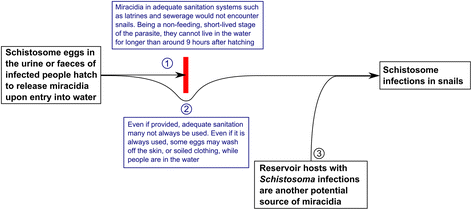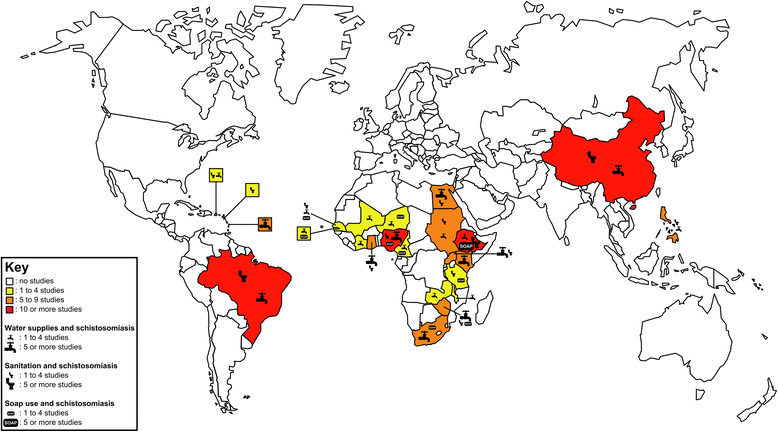The roles of water, sanitation and hygiene in reducing schistosomiasis: a review
- PMID: 25884172
- PMCID: PMC4377019
- DOI: 10.1186/s13071-015-0766-9
The roles of water, sanitation and hygiene in reducing schistosomiasis: a review
Abstract
Schistosomiasis is a disease caused by infection with blood flukes of the genus Schistosoma. Transmission of, and exposure to, the parasite result from faecal or urinary contamination of freshwater containing intermediate host snails, and dermal contact with the same water. The World Health Assembly resolution 65.21 from May 2012 urges member states to eliminate schistosomiasis through preventive chemotherapy (i.e. periodic large-scale administration of the antischistosomal drug praziquantel to school-aged children and other high-risk groups), provision of water, sanitation and hygiene (WASH) and snail control. However, control measures focus almost exclusively on preventive chemotherapy, while only few studies made an attempt to determine the impact of upgraded access to safe water, adequate sanitation and good hygiene on schistosome transmission. We recently completed a systematic review and meta-analysis pertaining to WASH and schistosomiasis and found that people with safe water and adequate sanitation have significantly lower odds of a Schistosoma infection. Importantly though, the transmission of schistosomiasis is deeply entrenched in social-ecological systems, and hence is governed by setting-specific cultural and environmental factors that determine human behaviour and snail populations. Here, we provide a comprehensive review of the literature, which explores the transmission routes of schistosomes, particularly focussing on how these might be disrupted with WASH-related technologies and human behaviour. Additionally, future research directions in this area are highlighted.
Figures





References
-
- Steinmann P, Keiser J, Bos R, Tanner M, Utzinger J. Schistosomiasis and water resources development: systematic review, meta-analysis, and estimates of people at risk. Lancet Infect Dis. 2006;6:411–25. - PubMed
-
- Gryseels B, Polman K, Clerinx J, Kestens L. Human schistosomiasis. Lancet. 2006;368:1106–18. - PubMed
-
- Rollinson D. A wake up call for urinary schistosomiasis: reconciling research effort with public health importance. Parasitology. 2009;136:1593–610. - PubMed
Publication types
MeSH terms
Substances
Grants and funding
LinkOut - more resources
Full Text Sources
Other Literature Sources
Research Materials

